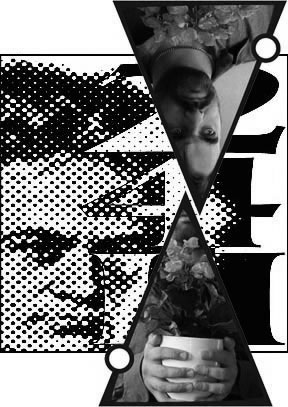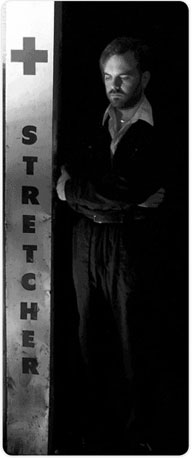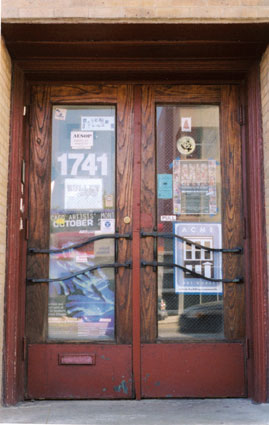Interview with Norwegian conceptual artist about his 24-hour sound piece “9 Beet Stretch”
By Scott Lockard
In a frenetic age where technology has sped up the way we live and interact with one another, some people are using technology to slow things down. Way, way, way, down. Norwegian conceptual artist Leif Inge has used state-of-the-art software to realize a project which up until now has been only fantasized about by sound practitioners. I am talking about his sound piece “9 Beet Stretch.” Inge, with the help of Bill Schottstaedt, has remarkably slowed down Beethoven’s “Ninth Symphony” to a glacier’s pace: 24 hours.
The piece is almost unrecognizable as Beethoven’s “Ninth.” Any similarity is practically wishful thinking. Notes of a frenzied string section hang in mid-air; the stentorious singer’s vocal cords of the “Ode to Joy” almost frozen in time; the uvula helping push sound into the listener’s ears.
The complexity of the “Ninth” is further pronounced while listening to it on this microscopic level. Fundamental notes and overtones of different instruments mingle and produce separate epic ambient pieces along the daylong journey. There are no crashes of cymbals; the tympani are reduced to a raga-like rumble. There is a lot of anticipation to reach familiar ground or a landmark in the piece. Often that anticipation is frustrated, leaving the listeners to ground themselves in the moment.
24 hours is a lot of time to commit to a piece of art. But Leif Inge is cool with that. He thinks of it not only as a listening experience, but a social one as well. The listening experience is usually accompanied by a sleep-over, people bringing their pajamas and lying in beds. This is a surreal prospect–it conjures up ideas of a society in suspended animation, a group of people frozen in a cryogenic-like state awaiting an unknown future with their life’s blood kept alive by this beautiful and eerie accompaniment.
In the following phone interview, we talked about the inspiration for the piece, the social aspect behind the work and the technology used to create it.
Freeradiosaic.org: You talk about how the piece doesn’t have a beginning or ending. Do you think the piece has a “stasis” or do you see it as having an “entropy” in Smithson’s vocabulary?
Leif Inge: Well, in practical terms, it does have a beginning and an end, but it takes such a long time in between that you don’t see it that way anymore, except as the reference it has to its source that you will never be able to escape. You know it’s Beethoven’s “Ninth” stretched, and now it’s at the beginning of it or end of it. Those few who stay for 24 hours are the only ones who really experience it. So you experience it as a partial piece in which you know there is something else going on that you can’t be a part of. And that’s not a problem at all. In that sense it is more like an installation, but of course it is a concert too.
FR: In a public presentation of “9 Beet Stretch,” you were saying that to get the entire experience, you would encourage people to stay the entire 24 hours. It reminds me of reading about the debut of Andy Warhol’s Empire, the eleven-hour film of the Empire State building. That event was social in nature. The reading talked about people coming and going and occasionally viewing the piece. Do you see a difference between long-term audio pieces versus visual pieces in that way?
LI: Well, I don’t know the history of the Empire State building film, whether people actually stayed for eleven hours or not. I have had people stay for 24 hours. And that makes a huge impact because during twenty-four hours you need to do a lot of things. You need to eat, you need to go to the toilet, you need to live. And as people have been telling me, they come in, they lie down, they fall asleep and they wake up with entirely new people around them. It is a social experience that is very different from a concert in traditional terms. It’s more like going out hiking or something and you end up with people you didn’t know, and then you start getting along with them and you go out with them, except there, of course, you stay in the same place all the time. It is definitely a social experience.
FR: What do you think of people making comparisons to the original symphony?
LI: Well that’s obvious. You cannot avoid this, because it is what it is, and that is what it is meant to be about. And the comparison is maybe, people who know Beethoven’s “Ninth” very well; they are actually coming to the concert trying to figure out where they are and what you know. Those of us [who] don’t know it that well, we will always figure out, for example, where the choir part starts and things like that, so you will always listen to this piece with Beethoven in mind. So you might, for a majority of the time, actually forget it is still with you as a clear reference. And I’m not saying that Beethoven would be either happy or angry with this, but he’s with it.
FR: I’d like to talk a little about the technology used for realizing “9 Beet Stretch.” Do you find that your work relies heavily on current technologies? Or are there any projects that you are working on, which cannot to be realized because of certain technologies being yet out of reach?
LI: Well, in this case, the project relies a lot on luck. Because it’s not about technology per se. It’s not about showing how new technology can augment sound. I actually got the idea, figured out I wanted to execute this thing and found the right place to do it. But I had, obviously, the best technology available and even freeware on a Linux platform. And I found people who could help me [in] getting through the programming issues in it, et cetera. So I was very lucky in respect of finding the right software for this.
FR: Are there other technologies you’re working with right now? I mean, you know, not as an endorsement but…
LI: No, not really. I’m always working with ideas. The problem always comes up when I want to execute them. And there will be technical problems I cannot predict in the state of the idea. I work idea-based so I don’t necessarily need to know how to do things before I start doing them.
FR: What was involved in the realization of the project? How did you know it was finished? Were there unsuccessful versions of the project? Did any problems in the software have to be reworked in order for the project to be completed? What was that process?
LI: Well, I started out using the completely wrong software for this project and then found somebody who told me, why not to try this? And then, when I heard the result of sound software by Bill Schottstaedt, I was really in awe. I didn’t know it could get that good. And from then on, it only grew. No, I would have done this project even if it sounded awful, but the fact that it sounds good made it into what it is, because it was not obvious for me to make it into a concert. You know, it was more like, okay, let’s see if it’s possible to get it going somewhere and if the result is good, then we’ll see. It builds on something very close to zero.
FR: Was there something that inspired the idea for “9 Beet Stretch?” Was there something that you were working on at the time?
LI: Oh sure. I know very well the Douglas Gordon piece, 24-hour Psycho, where he augments the Hitchcock movie. In a way I could say I stole the idea from Douglas Gordon by stretching something down into a much longer time. I did think immediately when I read about his piece that it would be really great to do with sound. And I waited for it to happen, and it didn’t happen, so I decided to do it myself.
FR: I read that you said that it would be better to do it with sound, but it wasn’t really clear why.
LI: I would say that sounds like a misquotation from the New York Times, but I do think it was a great idea to do it with sound. I wouldn’t say necessarily better or worse. It would be a parallel idea and, as such, it works tremendously well.
FR: Do you think that even though it was a misquotation, the sound piece requires less senses to be able to concentrate on something like that?
LI: Well I imagine that to listen to this music for twenty-four hours is more feasible, for many people, than watching Psycho for twenty-four hours. I don’t know if that is true. That is my feeling about it. And what is left after stretching Beethoven [is] that it seems like aggressive music [and] makes it hard for you to get away from it. That is my experience. It’s really attractive in a very strange way to spend a lot of time with it. That’s basically what I mean when I’m saying I think it’s a very good idea to do so.
FR: Do you find a lot of people talking about a synesthetic-type experience, in terms of seeing certain imagery? I’ve read about people saying it’s, you know, like a Ligetti to Kubrick’s 2001 thing. Do you get a lot of people talking about the imagery they would experience?
LI: They talk about various thoughts which appear to them during the evening. Some of them might be more metaphorical and pictorial than others. But the 2001 thing is something I hear quite a lot, especially because the quiet parts sound very close to Ligetti. Ligetti is very much used in 2001 and of course the thing with this piece is, you get that link much, much stronger. In other words, the sleeping room in the end of 2001 –that link becomes very strong in this music in the situations with beds, for example, which I have done a few times.
FR: Do you find a sense of humor in any of your work?
LI: Of course. To do this would be a pun from the beginning, but of course even if it is a pun from the beginning, if you do it humorously, it has become strong enough as a piece by itself. Of course it is funny to stretch Beethoven’s “Ninth” to twenty-four hours. It works well on top of that. I don’t mind people thinking it is an entertaining idea or thinking that I’m crazy or have too much time to spend. That’s not a problem.
The upcoming schedule for the presentation of 9 Beet Stretch:
· October 22–23 at Zeke’s
Gallery in Montreal.
· October 30–31 at
Diapason Gallery in New
York.
The audio of this interview is available for listening at freeradiosaic.org in the archives section. For an unedited transcript of the interview email [email protected].
The piece is available for download at www.notam02.no/9/downloads.htm
9 Beet Stretch will also be available as a DVD, without the video, on the Table of the Elements label in the near future, November most likely. See www.tableoftheelements.com
Images courtesy of Leif Inge
November 2004









